|
Jump
Note: eBooks featuring the Coolpix cameras have been discontinued. |
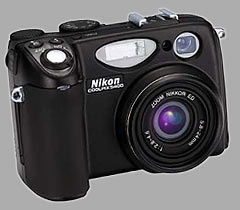 5 Megapixel Wide Zoom
Coolpix! 5 Megapixel Wide Zoom
Coolpix!The famed CP5000 Wide Angle Coolpix broke new ground for Nikon. Wide lens zoom cameras were rare when it came out and now the Coolpix 5400 brings a new idea to digital photography; a decent zoom range wide zoom camera. The 28 to 112 (35mm equivalent) zoom optic on the 5400 is sharp, capable and very decently wide. A note: Nikon calls this 28 to 116 mm but the math escapes me. The actual amount of enlargement from a wide to tele shot is virtually exactly 4:1, not the 4.14 suggested in the "28 to 116 mm" descriptor. Remember, Nikon called the CP5700 an 8:1 zoom but it really only made a 7.3:1 optical image size change over its full range. Five megapixels hits a quality plateau that will continue for years to come. A balance of detail, file size and match to reproduction requirements lets the magic 5 image fill full magazine pages, make great looking 11 x 14s, and still fit many shots into an affordable memory card. With the zoom range of the 5400, a photographer can work interiors at wide angle, modest telephoto and portrait ranges all with one camera. With the CP5400 in your pocket (coat? belt pouch? strap carry?) your range of options covers what 35mm cameras used to cover with a 28 mm, 35 mm, 50 mm, 85 mm and 105 mm set of prime lenses. And the package that contains all these is smaller by a significant degree than the previous CP5000. It's lower and thinner than the 5K. Zooming goes from f/2.8 at wide to f/4.1 at full tele, diminishing maximum aperture as it zooms. The reason for this is cost. It would cost you a huge amount of physical space and valuable money to have a lens that had a larger aperture at both ends of the zoom. The Sony DSC-F717 is a case in point. Huge lens/huge aperture/more expensive/not as wide angle. Lens Converters The major limitation of the CP5000 was its 28 to 84 mm lens (that and the flash sensor placement), but that camera continues to have something this camera won't obtain: the WC-E68 which gives it a 99 degree ultra wide capability. I wouldn't give up my 5000/WC-E68 combo, but there is hope for the CP5400. It takes the WC-E80, which at fifty kilos is a bit heavy (kidding), by using the reasonably priced adapter ring called a UR-E9.
The WC-E80 causes the CP5700 and 5400 to widen out by 25% (not a missprint) by effectively "shrinking" the original field of view down to 80% of its original coverage. This, in turn gives the picture a new "100% coverage" so the new part is 20% of the resulting full coverage width. People hear the "80" part and assume the improvement is 20% but its really 20/80ths in comparison, making the increase in angle a fuller 25%. End of lesson. If you are not confused enough by that, here's the fun result: The WC-E80 only takes the CP5700 to a 28 mm equivalent coverage, since its widest was 35 mm to start with. This always prevented me from bothering with the WC-E80. Too much weight, not enough benefit. This big, heavy, impressive piece of techno glass has been used about five times on the CP5700. Sheesh. But the CP5400 with the WC-E80 now becomes equivalent to a 22.4 mm wide angle lens on a 35mm camera, and that is comfortably (except for the weight) within the "super wide angle" realm of photography. Although the lens now weighs five hundred times the weight of the camera (still almost kidding) it does produce good coverage and does not vignette. The extreme corners of the image are on the soft side at full aperture, but stopping down to f/5.6 clears that up. The center 90% is sharp throughout. You can get away with most shots at full aperture since the corners are not usually centers of interest, but critical work and architectural photography will be best achieved from f5.6 to f/7.9. The zoom lens alone is sharp corner to corner at all apertures at wide setting. Chromatic aberrations are very low with the WC-E68 at all apertures, a small amount of blue fringing on low contrast subjects only in the extreme corners. It's superior wide converter and its a shame that it doesn't attach to the 5400. Barrel distortion is fairly low but certainly not absent, stronger than that of the WC-E68 on the 5000, and don't you know that a coming iNovaFX Photoshop Action Filter will clean that up. Note: Version 6.0 of the Nikon book is shipping with exactly the right iNovaFX anti-barrel filters. Look for the iBC54K series. How come it can't use the WC-E68 the way the CP5000 did? Glad you asked. The 5400's lens projects too far forward during zooming to accomodate it. Touch the zoom control and you can seriously harm your camera when the lens plows into the rear element of the WC-E68. It would work optically, and if Nikon had engineered the cameras with a zoom lock-out, it might have been possible to make this combination a viable alternative.
Every millimeter counts. This newer chip allows a zoom lens of nearly HALF the physical volume of the larger prior model, and it is lower in grain while making a picture that is just as sharp and detailed. Perhaps more detailed. The RGB chip comes from Sony and they use it in their new DSC-V1 which is slightly more acute than their F717--not in a major way, but just enough to notice in areas of fine detail. The CP5400 has another new thing for Nikon; ISO 50. This full-stop lower sensitivity is designed to capture lower noise, longer shutter speed images. But it has the side effect of lowering the whole sensitivity range of the camera to ISO 50, 100, 200 and 400--with no built-in ISO 800 or higher. For images at these elevated ISO's you will need to solve the exposure in software. The iNovaFX Photoshop Action Filters do the trick, and shots that are intentionally made up to two stops too dark can be teased back into useful photos with them. If you already own the Nikon eBook, try the iSO2Taste filter. Overall dynamic range for the 5400 is a bit better than what we have been seeing from Nikon in general. Highlights gently cross into maximum brightness and shadows have exceptionally good detail with enough definition to bring up tonal values in your digital darkroom to more pleasing levels, when desired. Each individual sensor is its own light meter of sorts. That's true in all digital imaging. When chip size goes down, so does the size of each sensor, which is itself a cubic volume of delicate electron/photon interaction. With an 83% scale sensor compared to the chip in the 5000 and 5700, its total volume is reduced dramatically. (1 x 0.83 x 0.83 x 0.83 = 55% of the original volume.) That has the beneficial effect of reducing the volume of the optics, but it potentially makes the individual sensor nearly twice as noisy. Performance of the chip at ISO 100 is about the same as it is on the 5700, so the technology of "small" isn't causing major problems here. Body Plan "Range finder" bodies have been around digital cameras from the beginning. Nikon's adaptation of the split body camera (900, 950, 990, 995, 4500) all featured optical viewfinders on the camera side of the split with a color monitor on the CF card side, and recent models, 5000, 5700 and 5400 have the next best thing, the flip-out monitor.
Direct sunlight always makes deployable monitors harder to see. The good news is that this one reads MUCH better in direct sunlight. Part of the image is reflected so you can gauge the view and read the numbers easier than with the 5700/5000. There is no black and white LCD on this camera such as is found on the 950/990/995/5000 and 5700 to report shutter speeds and f-stops as they are being set.
The color screen's swiveling plate is indented to accept an external viewing shade if you need. We have not seen a Nikon product for this, yet. In addition to the color LCD monitor, your other option for finding the view is the optical viewfinder and it follows the zoom mechanically, but it is hardly what one could call "accurate." Well, heck, none of them truly are. This one is more accurate than the one on some of my swivel cameras. The view it finds is only roughly centered and is very small compared to the image being captured. At wide angle the comparison between actual image and optical view is shown in white. At full tele, shown in blue, the centering improves and the view you find is larger, proportionally, but in both cases you are missing 20 to 25% of the linear measure of the view. Its saving grace is that anything you seen in the viewfinder is bound to end up on the image. The tele view you frame with the CP5400 is literally smaller than a 3 megapixel image pulled out of the full frame. And the wide view covers just 58% of the area of the actual image being taken (the camera captures the whole rectangle seen here). At full tele, the improvement--if you can call it that--is that now you see a whopping 63% of the area you are about to capture. Someone at Nikon thinks that erring on the side of caution --you know, to make sure photographers don' t miss seeing on the file what they saw in the viewfinder-- is worth giving up finding the view on over 40% of the image. Optical viewfinders can add a lot of cost to a camera and EVF systems consume a lot of volume. So its a grand compromise. Knowing this is step one to working around it. When you shoot with the optical viewfinder, make sure you understand its relationship to the full image. Crop tighter than you would with the monitor and you should be okay.
None of the recent optical viewfinder Nikons seem to get it very well centered or sized. Here's the same test run on a CP5000 for comparison --> Auto Focus Nikon autofocus has been steadily improving and the CP5400 shows a small, incremental improvement, if any. It's always difficult to judge whether a different camera would have gotten a specific image or not, unless both can be used on the exact same image at the exact same time. In tests designed to fool the CP5400, it seemed to achieve auto focus a slight bit better than the CP5000.
In light inside late afternoon shadows, the camera not only doesn't have a problem, but it tracks moving subjects--or subjects captured by a moving photographer--extremely well. The general feeling is that this camera is harder to fool than prior models. It doesn't fall for things that steal focus as much as the 9xx cameras, for instance. Motor Drives Where the CP4500 is the king of Macro, the CP5400 is King of Motor Drive options. It has the extremely fast Continuous H feature of prior cameras, but this time it gathers two images per second for seven shots. The Continuous L setting gathers --get this-- up to 25 full size FINE compressed images or 48 full size NORMAL compressed shots at a single whack. BASIC compression holds even more. Up to about 85. Down side: Time to store the images can run up to 3.5 minutes (FINE) to 7.5 minutes (BASIC) when the buffer is full. Another mode gives you a five-shot buffer that clears quickly. It's like a limited version of the Continuous Low mode. And it is appreciated. Movie Drives As with cameras of the past, this is not a video cam. But it is getting close. Movie options allow small images--all with sound--but the big cookie is the 15fps VGA frame size images from the largest option. Full screen TV images (640 x 480 NTSC size) are the result and they're too big for Internet use. Length of shot is 180 seconds maximum. Once you seek to review a full scene in the camera, it needs to load the whole thing off the CF card back into the reviewing buffer and that can take 30 seconds or so. For Internet movie sharing, use the QVGA (320 x 240) image. During movie playback you can hear a reference audio track emanating from the camera's left side. Hold it up to your ear if audio reviewing is important. But of course you can't see the picture this way. Audio is poor from the tiny internal speaker, but convenient for field use. Both size movies take up about 49 megabytes. Yow! But that's only 16 per minute. After finishing your 3-minute shot, saving the file to CF card takes about 45 seconds. In the middle of a playback shot, you can pause and step frames to and fro, then resume playback with sound. This makes the machine into a 15 fps motion-analysis player. For exotic motion control, there are two other modes of interest. Ultra HS grabs a whopping 100 frames at 30 per second, but storage takes a long time --several minutes-- and reviewing requires you to advance each frame with a button press. Not only that, but the shots that took so darn long to store are teeny weeny QVGA size and are very crummy quality. What took so long? These things are around 26K each. Meaning microscopic. What WERE you thinking about? Then there's 16-shot with its 3 per second frame rate and big comic strip like print with your very high quality images arranged 4 by 4 each 648 x 487 pixels--slightly larger than VGA. That's handy for sequence shooting but is not a major motor drive technique.
Balanced Whites Good white balance is usually desired and Nikon's colorimetry has always been known for its accuracy. Especially in the factory presets which in this camera are joined by a new option. Daylight, Incandescent, 3-level Fluorescent, Cloudy and Flash are joined by Daylight Shade, a small tweak different from Cloudy. Of course Manual (called "Preset") and Auto WB are in there, too. The CP5400 uses the same new, smaller image chip found in the Sony V1 and when I compared two Auto WB shots of the same night scene from each, I got a major surprise when I compared the two: The Sony is on the left, shot at ISO 200 with an EV -0.3 adjustment. The Nikon, on the right, was captured at ISO 50 using BSS at EV 0.0. Yes, they do look different from each other.
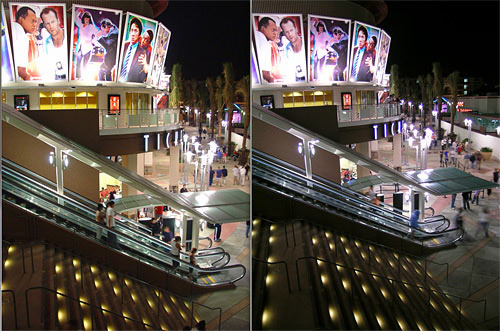 I felt that the Sony image looked warmer and more like my experience of the place where the architects and lighting designers have tried to strike a balance between warmth and economical area lighting. I wondered what it would take to make the CP5400 image look more like the one from the V1. So I created a new iNovaFX Photoshop Action Filter to bring it to that standard:
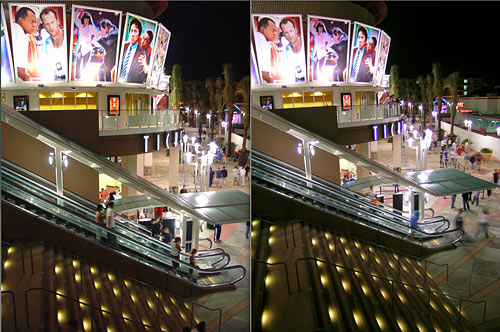 It certainly does the job and holds values well all around. The slightly wider Nikon shot is easy to spot. What has happened here is that two different cameras are now color balanced to each other without extra effort, except for the one button click filtration step. Both cameras can be set to complete auto and gather images of the same subject, then have their results mixed on a page without viewers perceiving that something strange is going on. You can spot small differences, but 99+% of the world would think they were shot from the same camera moments apart in stead of five days apart. To confirm my results, I made a version that would take the V1 over to the CP5400's look. That worked too:
 Certainly this bears more experimentation, but the fundamental result is that these informal tests show how compatible these cameras can be, when pushed a little. These proof of concept iNovaFX Actions will not appear in future eBooks.
Featured Features The CP5400 is pretty much a CP5000 plus a little. It's smaller, the zoom is larger and the feature set has grown. Things to appreciate:
The menu system is now much more refined. A "faves" page (called My Menu) allows you to cluster the things you wish to change the most often on the first menu page. Nice, that.
Images from the 5400 seem to have all the earmarks of current Nikon compact camera setup. Great colorimetry, good shadow detail, crisp contrast and about the same per-pixel detail of the CP5000. Plus, plus, plus. Focus Pokus In the dark, forget it. You'll have to zone focus with the bar graph manual focus thing. This is the fourth camera Nikon has produced with this very poor manual focus system. Shame on them. And it's about time for Nikon to wake up and realize not all images are captured with well lit subjects. Foo. Note: with several months of experience, including a lot of dark situations like dimly lit museums under my belt, I'm not so crushed by the poorer low light performace of the 5400. It does work into the sub-1 candlepower range and brings back images like this and considerably dimmer lit subjects. Moving subjects, such as your friend or dog or both can confuse it in low light. Still, Nikon needs to address the low light focus problem head-on. They've been dragging their engineering feet on this idea too long and the low light focus techniques embodied in the Sony V1 blows the 5400 away. Other features of the 5400 blow the V1 away, so there you are.
Goodnesses + A new
white balance factory preset: Daylight Shade. Drawbacks - Optical
Viewfinder shows 58 to 63% of the real area coverage. Nothing major, and most of this is old: Nikon's Department of Ergonomic Digital Photography needs a wake-up call. They've perpetuated some old chestnuts for a long time without coming to grips with these minor gripes. Here's one now: 1. The dedicated Quick Review button does what? It switches you to review mode first with a 1/4 screen thumbnail image, then with a full screen image with a second button press. Half-pressing the shutter release dismisses the view. Now tell me again how that 1/4 screen thumbnail is useful? All it does for me is turn the function into a Not So Quick Review. Other brands don't perform this intermediate small image and I think it's time for the useless small thumbnail to leave the operating system of future Nikons. Is there anybody out there who NEEDS that 1/4 screen view? I am SO GLAD that I don't have that feature on my other cameras. No names, but think four letter words ending in "ony." Note: The entire item #1 is reprinted verbatim from the CP5700 review. It applied then and it still applies today. They don't get it. Either that, or I don't, and I have several other cameras by other manufacturers that do NOT have the dumb 1/4 screen review feature. 99.99% of the time it gets in my way. 0.01% of the time it is useful. Dang. 2. That zone focus thing. @#$%!! Give me a distance focus NUMBER! Then again, to be fair, so MANY features are under this hood that a few shortcomings may be inevitable.
On Balance After a month of working with the 5400, I'm inclined to recommend it to people. You want more weight and bigger zoom? Get the 5700 or something else. You want a very generous zoom range and plenty of native wide angle? The 5400 strikes a chord that is loud and sweet. The Coolpix 5400 is Nikon's answer to all those folks who wanted a zoomier lens in the CP5000. It differentiates the 5000 as the Wide, Short Zoom Cam and becomes the Wide+Tele Cam itself. The 5000 still has the wide edge with the WC-E68 in place, but the wide angle possibilities of the 5400 are quite good. The WC-E80 wide converter turns the 5400 into a very heavy 22.4mm wide angle, not enough of a change to be worth the weight, most of the time. It's impressive, but holy cow, what a monster piece of glass! Okay, it is worth the weight if you are a wide angle nut, as I am. To do major architectural images with this combo, you'll need the iNovaFX PAFs that flatten the image, but once done, the shots are impressive. The 5400 has the full range of image manipulations Nikon's are known for with BSS, NR, Contrast +/- (Oddly, no "Brightness +/-" which was more of a gamma adjustment), Saturation +/-, Speedlight +/- and even factory White Balance setting +/- adjustments. Real handy for turning cloudy days into eternal Golden Hour. Just set Cloudy to -3 and warm up everything. Bottom line: Nikon Coolpix 5400: A-* -iNova, December, 2003 (Updated over time) *US school grading system uses A as its top score although some teachers give A+ and the extremely rare A++ grades for exceptionally outstanding work. C = Average. B = Better than Average, but not top scoring. D=Not as good as Average. F=Failing. What happened to E? There is no such grade.
Don't just take my word for it! Read the reviews and previews from the digital camera testers: Digital Photography Review of the Coolpix 5400 |
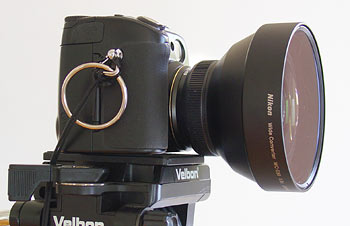 Geometry
lesson:
Geometry
lesson: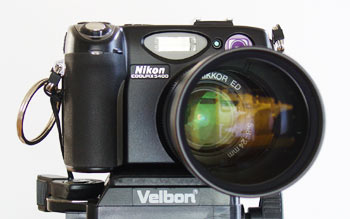 The
CP5400 also uses the other converters that fit to the CP5700,
the TC-E15ED telephoto converter with its 50% farther reach.
This works very well with the CP5400 when it is set to full telephoto.
Now the previous 112 mm tele equivalent becomes a 168 mm equivalent.
And results with this optic are sharp at all apertures. The TC
is of reasonable weight, too. Pocketable.
The
CP5400 also uses the other converters that fit to the CP5700,
the TC-E15ED telephoto converter with its 50% farther reach.
This works very well with the CP5400 when it is set to full telephoto.
Now the previous 112 mm tele equivalent becomes a 168 mm equivalent.
And results with this optic are sharp at all apertures. The TC
is of reasonable weight, too. Pocketable.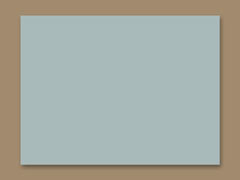 The
image chip in the 5400 is around 83% of the size of the one in
the CP5000/CP5700s. Theirs is an 8.8 x 6.6 mm image surface and
the CP5400's is 7.3 x 5.4 mm. The illustration at right shows
how this compares.
The
image chip in the 5400 is around 83% of the size of the one in
the CP5000/CP5700s. Theirs is an 8.8 x 6.6 mm image surface and
the CP5400's is 7.3 x 5.4 mm. The illustration at right shows
how this compares.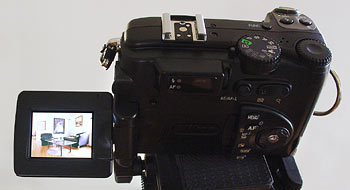 It's
bright, sharp and good for finding the view, but it should not
be confused with higher purposes such as judging the quality
of the image in review.
It's
bright, sharp and good for finding the view, but it should not
be confused with higher purposes such as judging the quality
of the image in review.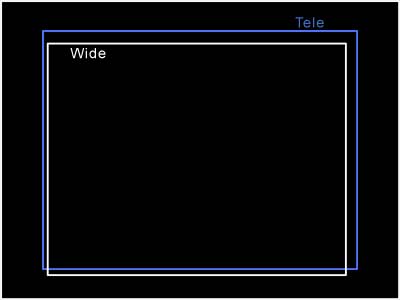 Under some conditions
--manual exposure settings, for instance-- the color LCD viewing
screen is your only hope, and when it can't be seen well enough
to tell what your setting is, you're out of luck.
Under some conditions
--manual exposure settings, for instance-- the color LCD viewing
screen is your only hope, and when it can't be seen well enough
to tell what your setting is, you're out of luck. I've
railed against Nikon's poor optical viewfinder alignments in
the past, but this is silly. The CP5000 shows a more consistent
framing over its zoom range and covers 69% of the actual image
obtained, but man, is it off center!
I've
railed against Nikon's poor optical viewfinder alignments in
the past, but this is silly. The CP5000 shows a more consistent
framing over its zoom range and covers 69% of the actual image
obtained, but man, is it off center!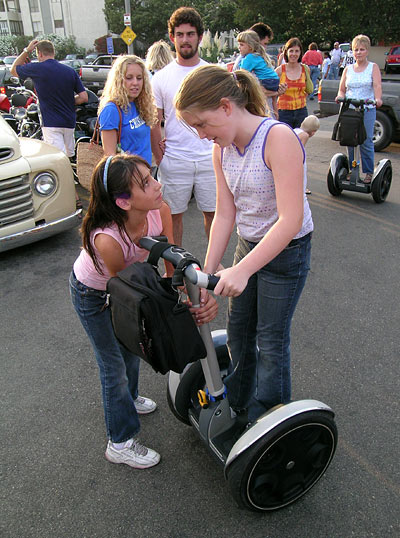 As
the camera enters into attempting focus with the monitor closed
or switched off, the camera does an extra bit of work trying
to get it right. It takes a fraction of a second extra to zero
in on the problem but it gets it right more often than with the
LCD turned on.
As
the camera enters into attempting focus with the monitor closed
or switched off, the camera does an extra bit of work trying
to get it right. It takes a fraction of a second extra to zero
in on the problem but it gets it right more often than with the
LCD turned on.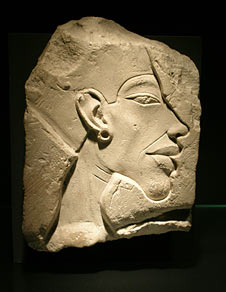 Image
Image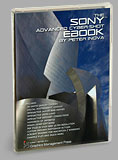
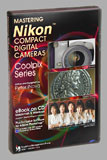
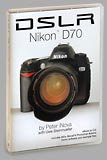 Get the eBooks
Get the eBooks